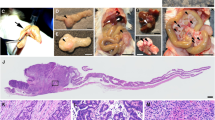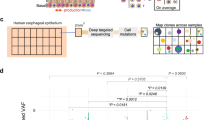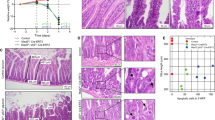Abstract
Individuals inheriting the same mutation predisposing to cancer may show very different outcomes, ranging from early aggressive cancer to disease–free survival. Experimental mouse models can provide a powerful tool to identify factors in the environment and genetic background that account for such modifications. The Min mouse strain1, in which the ApcMin mutation disrupts the mouse homologue of the human familial polyposis gene2, develops intestinal neoplasms whose multiplicity is strongly affected by genetic background3. We previously mapped4,5 a strong modifier locus, Mom1 (modifier of Min–1), to a 4–cM region on mouse chromosome 4 containing a candidate gene Pla2g2a encoding a secretory phospholipase6. Here, we report that a cosmid transgene overexpressing Pla2g2a caused a reduction in tumour multiplicity and size, comparable to that conferred by a single copy of the resistance allele of Mom1. These results offer strong evidence that this secretory phospholipase can provide active tumour resistance. The association of Pla2g2a with Mom1 thus withstands a strong functional test and is likely to represent the successful identification of a polymorphic quantitative trait locus in mammals.
This is a preview of subscription content, access via your institution
Access options
Subscribe to this journal
Receive 12 print issues and online access
$209.00 per year
only $17.42 per issue
Buy this article
- Purchase on Springer Link
- Instant access to full article PDF
Prices may be subject to local taxes which are calculated during checkout
Similar content being viewed by others
References
Moser, A.R., Pitot, H.C. & Dove, W.F. A dominant mutation that predisposes to multiple intestinal neoplasia in the mouse. Science 247, 322–324 (1990).
Su, L.-K. et al. A germline mutation of the murine homolog of the APC gene causes multiple intestinal neoplasia. Science 256, 668–670 (1992).
Shoemaker, A.R., Gould, K.A., Luongo, C., Moser, A.R. & Dove, W.F. Studies of neoplasia in the Min mouse. Biochim. Biophys. Acta Rev. Cancer 1332, F25–F48 (1997).
Dietrich, W. et al. Genetic identification of Mom-1, a major modifier locus affecting Min-induced intestinal neoplasia in the mouse. Cell 75, 631–639 (1993).
Gould, K.A. et al. Genetic evaluation of candidate genes for the Moml modifier of intestinal neoplasia in mice. Genetics 144, 1777–1785 (1996).
MacPhee, M. et al. The secretory phospholipase A2 gene is a candidate for the Mom1 locus, a major modifier of ApcMin-induced intestinal neoplasia. Cell 81, 957–966 (1995).
Gould, K.A., Dietrich, W.F., Borenstein, N., Lander, E.S. & Dove, W.F. Mom1 is a semi-dominant modifier of the size and multiplicity of intestinal adenomas in Min mice. Genetics 144, 1769–1776 (1996).
Gould, K.A. & Dove, W.F. Action of Min and Mom1 on neoplasia in ectopic intestinal grafts. Cell Growth Diff. 7, 1361–1368 (1996).
Gould, K.A. & Dove, W.F. Localized action controlling intestinal neoplasia in mice. Proc. Natl. Acad. Sci. USA 94, 5848–5853 (1997).
Tischfield, J.A. et al. Low-molecular-weight, calcium-dependent phospholipase A2 genes are linked and map to homologous chromosome regions in mouse and human. Genomics 32, 328–333 (1996).
Peeters, T. & Vantrappen, G. The paneth cell: a source of intestinal lysozyme. Gut 16, 553–558 (1975).
Rhodin, J.A.G. Histology: A Text and Atlas (Oxford University, New York, 1974).
Oshima, M. et al. Suppression of intestinal polyposis in ApcÆ716 knockout mice by inhibition of cyclooxygenase 2 (COX-2). Cell 87, 803–809 (1996).
Reddy, S.T. & Herschman, H.R. Prostaglandin synthase-1 and prostaglandin synthase-2 are coupled to distinct phospholipases for the generation of prostaglandin D2 in activated mast cells. J. Biol. Chem. 272, 3231–3236 (1997).
Harwig, S.S.L. et al. Bactericidal properties of murine intestinal phospholipase A2 . J. Clin. Invest. 95, 603–610 (1995).
Dove, W.F. et al. Intestinal neoplasia in theApcMin mouse: independence from the microbial and natural killer (beige locus) status. Cancer Res. 57, 812–814 (1997).
Dudley, M.E., Sundberg, J.P. & Roopenian, D.C. Frequency and histological appearance of adenomas in multiple intestinal neoplasia mice are unaffected by severe combined immunodeficiency (scid) mice. Int. J. Cancer 65, 249–253 (1996).
Tomlinson, I.P., Beck, N.E., Neale, K. & Bodmer, W.F. Variants at the secretory phospholipase A2 (PLA2G2a) locus: analysis of associations with familial adenomatous polyposis and sporadic colorectal tumors. Ann. Hum. Genet 60, 369–376 (1996).
Spirio, L.N. et al. Three secretory phospholipase A2 genes that map to human chromosome 1P35-36 are not mutated in individuals with attenuated adenomatous polyposis coli. Cancer Res. 56, 955–958 (1996).
Lander, E.S. & Botstein, D. Mapping mendelian factors underlying quantitative traits using RFLP linkage maps. Genetics 121, 185–199 (1989).
Hamilton, B.A. et al. The vibrator mutation causes neurodegeneration via reduced expression of PITPα: positional complementation cloning and extragenic suppression. Neuron 18, 711–722 (1997).
King, D.P. et al. Positional cloning of the mouse circadian clock gene. Cell 89, 641–653 (1997).
Dove, W.F. Molecular genetics of Mus musculus: point mutations and millimorgans. Genetics 116, 5–8 (1987).
Altshul, S.F., Gish, W., Miller, W., Myers, E.W. & Lipman, D.J. Basic alignment search tool. J. Mol. Biol. 215, 403–410 (1996).
Sambrook, J., Fritsch, E.F. & Maniatis, T., Cloning: A Laboratory Manual (Cold Spring Harbor Laboratory, Cold Spring Harbor, New York, 1989).
Halberg, R. & Kroos, L. Fate of the SpoIIID switch protein during Bacillus subtilis sporulation depends on mother-cell sigma factor, σk . J. Mol. Biol. 228, 840–849 (1992).
Wagle, A., Desai, S. & Deo, M.G. Immunohistochemical localization of ‘enhancing factor’, a novel growth modulator in the mouse intestines. Cell Biol. Int. Rep. 13, 309–312 (1989).
Mulherkar, R. et al. Enhancing factor protein from mouse small intestines belongs to the phospholipase A2 family. FEBS Lett. 317, 263–266 (1993).
Mulherkar, R., Desai, S.J., Rao, R.S., Wagle, A.S. & Deo, M.G. Expression of enhancing factor gene and its localization in mouse tissues. Histochemistry 96, 367–370 (1991).
Author information
Authors and Affiliations
Rights and permissions
About this article
Cite this article
Cormier, R., Hong, K., Halberg, R. et al. Secretory phospholipase Pla2g2a confers resistance to intestinal tumorigenesis. Nat Genet 17, 88–91 (1997). https://doi.org/10.1038/ng0997-88
Received:
Accepted:
Issue Date:
DOI: https://doi.org/10.1038/ng0997-88
This article is cited by
-
Pla2g2a promotes innate Th2-type immunity lymphocytes to increase B1a cells
Scientific Reports (2022)
-
CD36 polymorphisms and the age of disease onset in patients with pathogenic variants within the mutation cluster region of APC
Hereditary Cancer in Clinical Practice (2021)
-
A network view of microRNA and gene interactions in different pathological stages of colon cancer
BMC Medical Genomics (2019)
-
Genetic analysis of intestinal polyp development in Collaborative Cross mice carrying the Apc Min/+ mutation
BMC Genetics (2016)
-
Genetic dissection of the Mom5 modifier locus and evaluation of Mom5 candidate genes
Mammalian Genome (2015)



